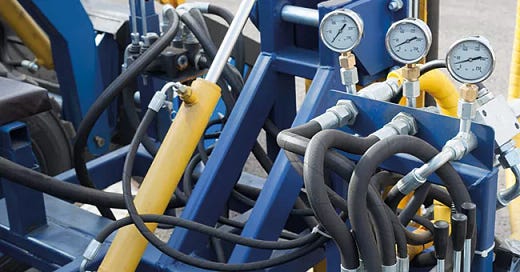The Fluid Power Equipment Market: Asia-Pacific's Ascendancy
This article explores the factors contributing to the rapid expansion of the fluid power equipment market in Asia-Pacific, highlighting key trends, challenges, and the future outlook.
Introduction:
The Fluid Power Equipment Market has emerged as a crucial component of various industries, particularly in the manufacturing sector. With Asia-Pacific at the forefront of this growth, driven by countries such as China, India, and Japan, the region is set to dominate the fluid power equipment landscape in the coming years.
Download FREE Sample: https://www.nextmsc.com/fluid-power-equipment-market/request-sample
Understanding Fluid Power Equipment
Fluid power equipment encompasses a range of systems that use hydraulic and pneumatic power to perform work. This includes components such as pumps, valves, actuators, and cylinders. Fluid power systems are widely utilized across various industries, including manufacturing, construction, automotive, and aerospace, due to their efficiency and reliability in transmitting energy.
Key Features of Fluid Power Equipment
Efficiency: Fluid power systems can transmit large amounts of power with minimal energy loss, making them highly efficient.
Precision Control: These systems allow for precise control of speed and force, which is essential in many industrial applications.
Compact Design: Fluid power equipment can be designed to occupy minimal space, making them ideal for applications with limited space.
Asia-Pacific: The Fastest-Growing Region
1. Robust Manufacturing Sector
The manufacturing sector in Asia-Pacific is experiencing unprecedented growth. According to a report by Invest India, the sector accounted for 17% of the GDP in 2023 and is projected to reach 25% by 2025. This expansion is driven by several factors:
Government Initiatives: Various governments in the region are promoting policies that encourage manufacturing, including tax incentives and investment in infrastructure.
Foreign Direct Investment (FDI): Increased FDI in countries like China and India is driving the establishment of manufacturing plants, leading to higher demand for fluid power equipment.
2. Technological Advancements
The rapid technological advancements in fluid power systems are transforming the landscape of the industry. Innovations such as smart hydraulics and IoT-enabled systems are becoming increasingly common, enhancing efficiency and reliability.
Automation: The integration of automation in manufacturing processes has heightened the demand for advanced fluid power equipment that can support automated systems.
Energy Efficiency: As industries strive for sustainability, the demand for energy-efficient fluid power solutions is growing. Manufacturers are focusing on developing products that consume less energy and reduce environmental impact.
3. Increasing Demand for Advanced Equipment
The expansion of industries such as automotive, aerospace, and construction in Asia-Pacific is driving the demand for advanced fluid power equipment.
Automotive Industry: The growing automotive sector, particularly in countries like China and India, requires sophisticated fluid power systems for assembly lines and manufacturing processes.
Construction Sector: The booming construction industry is also a significant contributor to the demand for fluid power equipment, with hydraulic systems being essential for machinery like excavators and cranes.
Key Players in the Asia-Pacific Fluid Power Equipment Market
Several major players dominate the fluid power equipment market in Asia-Pacific, contributing to the industry's growth through innovation and strategic partnerships.
1. Bosch Rexroth AG
Bosch Rexroth is a global leader in fluid power technologies, offering a wide range of hydraulic and pneumatic systems. The company’s commitment to innovation and sustainability has made it a preferred choice among manufacturers in the region.
2. Parker Hannifin Corporation
Parker Hannifin is known for its extensive portfolio of fluid power equipment, including pumps, valves, and actuators. The company focuses on providing energy-efficient solutions tailored to the needs of various industries.
3. Eaton Corporation
Eaton Corporation is another key player, specializing in hydraulic and pneumatic solutions. The company’s emphasis on research and development enables it to deliver advanced fluid power technologies that enhance performance and reduce energy consumption.
Challenges Facing the Fluid Power Equipment Market
1. Economic Fluctuations
While the Asia-Pacific region is experiencing growth, economic fluctuations can pose challenges. Factors such as trade tensions, currency volatility, and inflation may impact manufacturing operations and, consequently, the demand for fluid power equipment.
2. Skilled Labor Shortages
The fluid power industry requires a skilled workforce to operate and maintain advanced systems. A shortage of skilled labor in some regions may hinder growth and innovation in the market.
3. Environmental Regulations
Increasingly stringent environmental regulations may impose challenges on manufacturers in the fluid power equipment market. Companies will need to invest in developing eco-friendly products to comply with these regulations while meeting market demands.
Future Outlook
1. Continued Growth of the Manufacturing Sector
The growth of the manufacturing sector in Asia-Pacific is expected to continue, further driving demand for fluid power equipment. With ongoing investments in infrastructure and manufacturing capabilities, the region is set to remain a global manufacturing hub.
2. Emphasis on Sustainability
As sustainability becomes a priority for industries worldwide, the fluid power equipment market will likely see a shift towards eco-friendly solutions. Manufacturers that focus on developing energy-efficient and sustainable products will gain a competitive edge.
3. Technological Innovations
The future of the fluid power equipment market will be heavily influenced by technological advancements. The integration of smart technologies and IoT solutions will enhance the efficiency and performance of fluid power systems, catering to the evolving needs of industries.
Conclusion
The fluid power equipment market is on an upward trajectory, with Asia-Pacific leading the charge. The region's robust manufacturing sector, driven by technological advancements and increasing demand for advanced equipment, is reshaping the landscape of fluid power systems. As the industry faces challenges such as economic fluctuations and labor shortages, the focus on sustainability and innovation will play a crucial role in determining the future of fluid power equipment.
With key players like Bosch Rexroth, Parker Hannifin, and Eaton at the helm, the Asia-Pacific fluid power equipment market is poised for continued growth, offering opportunities for manufacturers, investors, and consumers alike. As industries embrace automation and strive for efficiency, the demand for fluid power equipment will remain a vital aspect of the region's economic development.




